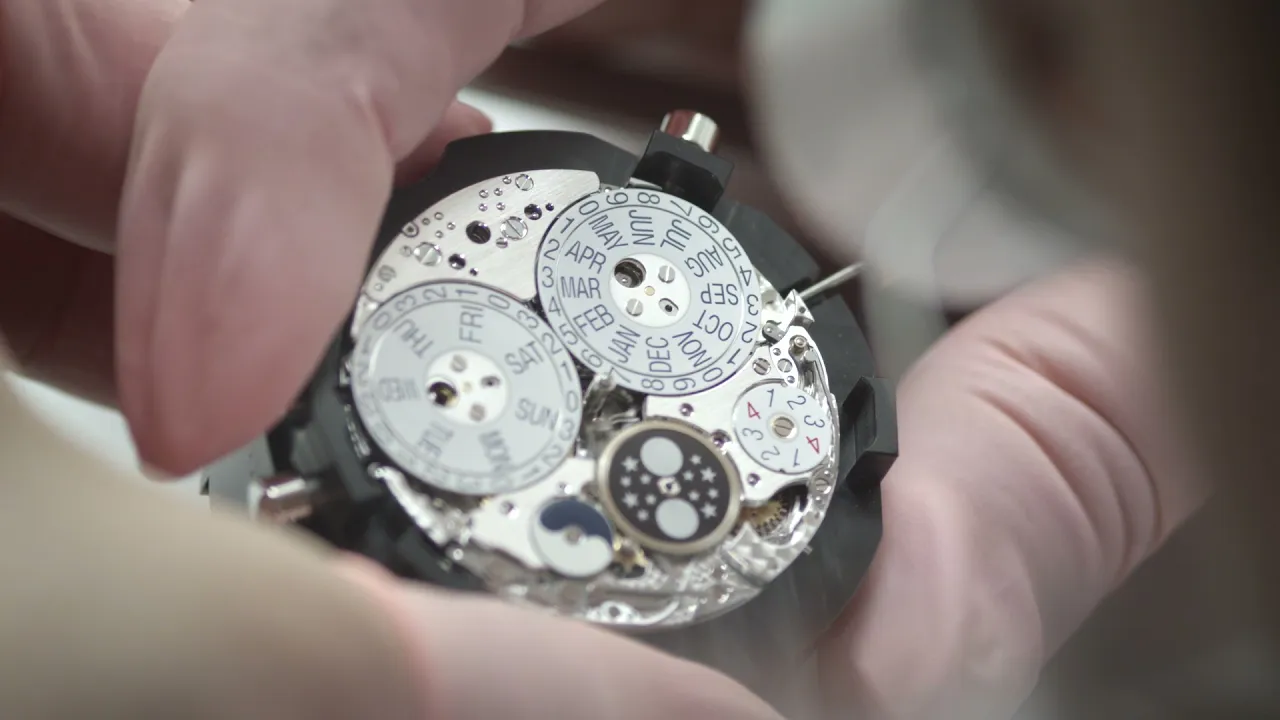The manufacture has expanded its rich range of calendar watches with the addition of a perpetual calendar that displays the day, the date, and the month on a single line in an elongated aperture beneath 12 o’clock. To combine this unique feature with crisp legibility and high reliability, the designers developed a new self-winding movement for which three patent applications have been filed. This new in-line perpetual calendar, the Patek Philippe Ref. 5236P-001 In-line Perpetual Calendar premières in an elegant platinum case with a blue dial.
As classic grand complications par excellence, perpetual calendars have always been prominently featured in Patek Philippe’s collections. In 1925, the Genevan manufacture presented the first wristwatch with this highly elaborate complication (movement No 97’975; the watch is on display at the Patek Philippe Museum in Geneva, No. P-72). Patek Philippe perpetual calendars offer a wide range of design elements with analog or aperture displays and dial configurations. Models with the famous self-winding ultra-thin caliber 240 Q movement, such as the Ref. 5327, can be recognized by their day, date, and month displays in three separate subsidiary dials.

The self-winding caliber 324 S Q, which among others powers the Ref. 5320, exhibits another traditional face among the manufacture’s perpetual calendars. It features a dual aperture for the day and month at 12 o’clock and a subsidiary dial at 6 o’clock for the analog date and the moon-phase display. The caliber 324 S QR also ticks in the Ref. 5160 and features an added complication: the date display with a retrograde hand that sweeps an arc from 8 to 4 o’clock. It is complemented with four aperture displays for the day of the week at 9 o’clock, the month at 3 o’clock, the leap year cycle at 12 o’clock, and the moon phases at 6 o’clock.

A new face for a brand-defining grand complication
With the launch of the Ref. 5236P-001, Patek Philippe gives the perpetual calendar a new face. For the new Ref. 5236P-001, this watch presents an innovative indication of the day, date, and month in an elongated aperture at 12 o’clock. A panoramic aperture of this kind is not totally unprecedented in the manufacture’s collections. In the course of time, the manufacture had already crafted pocket watches with an in-line calendar display for the American market. Customers in the new world were enthusiastic about complicated watches that were easy to operate and showed the indications of the perpetual calendar at a glance. One example of such timepieces is on display at the Patek Philippe Museum: it is a pocket watch from 1972 (No. P-1450) that features a calendar format “à l’américaine” (month, date, day). But never before has the manufacture introduced a wristwatch with a full calendar on a single line as exemplified by the new Ref. 5236P-001.

To implement this masterpiece of miniaturization, Patek Philippe had to overcome totally new technical challenges. To assure the largest possible calendar display on a single line with optimized legibility, the developers were asked to design a system with two date disks – one for the tens and one for the units. So the calendar display consists of four disks, one for the day, two for the date, and one for the month – all four perfectly embedded in the same plane. A single date disk with 31 numerals would have been too small and less easily legible. In compliance with the manufacture’s basic principles as set forth in the directives of the Patek Philippe Seal, the new, complex mechanical ensemble had to be implemented with the smallest possible diameter and minimized height without compromising its maximum long-term dependability. For this reason, the project team proceeded on the basis of the caliber 31-260 REG QA that was originally launched in 2011 with the Ref. 5235 Annual Calendar Regulator. Not least because of its eccentric recessed minirotor, this self-winding movement with subsidiary seconds at 6 o’clock is extremely slender.

A new self-winding movement with optimized performance
While retaining the diameter and height of the basic movement (31.74 x 2.60 mm, hence the designation 31-260), the engineers completely reworked the new caliber 31-260 PS QL (PS for petite seconde [subsidiary seconds] and QL for “quantième perpétuel en ligne“ [in-line perpetual calendar]) and integrated the manufacture’s latest technical achievements. The movement was “tuned”, so to speak, so it could drive the particularly energy-hungry perpetual calendar mechanism.

The torque of the spring barrel was increased by 20% and the winding power boosted with a platinum minirotor that has more mass than 22K gold that is normally used for Patek Philippe minirotors. Rate stability was improved by increasing the frequency from 3.2 to 4 Hz (28,800 semi-oscillations per hour) which also simplifies precision adjustments to the rate tolerance specified by the Patek Philippe Seal.

Moreover, the caliber 31-260 PS QL is fitted with a reduction wheel that uncouples the automatic winder as soon as the movement is being manually wound. This is a Patek Philippe invention patented in 2019 that reduces wear. The aesthetic appeal of the movement is subtly evolved with two distinctive bridges for the escapement and the fourth wheel.

Their configuration made the work of the engineers more difficult but it affords a better view of the basic movement’s wheel train, overall architecture, and refined finissage as revealed by the sapphire-crystal caseback. This back can be substituted with a solid platinum back that is delivered with the watch.

An innovative display mechanism crowned by three patents
The perpetual calendar mechanism (including a 12-month cam and a satellite cam for the month of February) is designed as a separate module with its own plate. This is a preferred solution for this movement, thanks to which the overall height of the caliber is smaller than with a partially integrated mechanism. The connection of the calendar with the basic movement is established with an intermediate wheel that engages with the hour-wheel pipe (a pinion that controls the minute hand). This second minute wheel is suspended between two jewels and meshes with a 24-hour wheel, also between jewels, which guarantees optimized energetic efficiency.

But the most innovative aspect is the single-line calendar display with four rotating disks, assuring optimized legibility, minimal energy consumption, and superb reliability. This mechanism alone required 118 additional parts in comparison with a conventional perpetual calendar display, including several bridges and wheels with jewel bearings that reduce energy consumption, especially of the two date disks. To keep all the indications on one plane without any overlap, Patek Philippe’s engineers developed a display system composed of two coplanar double ball bearings for which a patent application has been filed. The dependable date display and the perfect synchrony of the two date disks are optimized with an “anti-double-jump” feature for the units disk to prevent disk bounce in the event of a jolt or when a date correction is being performed (second patent application). The transition from the 31st day to the 1st day of the next month is the subject of the third patent application for a mechanism that immobilizes the units disk. This is done with a 31-point date star from which two teeth were removed.

The switching of the calendar displays is gradual. The display of the day, date, and month on a single line is complemented with two small round apertures, one at 4 o’clock for the leap year cycle and one at 8 o’clock for the day/night indicator. This information is very useful when the calendar needs to be set. The moon phases, an essential element of Patek Philippe’s perpetual calendars, are tracked with very high precision in a window within the subsidiary seconds dial at 6 o’clock. To facilitate the adjustment of the functions, three correctors – for the day, the date, and the month – are recessed in the case flank between 9 and 2 o’clock, in the same order as the respective displays. The moon phase corrector is positioned at 8 o’clock.

Timeless beauty
The looks of the new Ref. 5236P-001 in platinum are inspired by the Ref. 5235 Annual Calendar Regulator. It features a very sleek case with a diameter of 41.3 mm and a chamfered bezel. This unassuming architecture is emphasized with polished finissage that is executed by hand according to venerable Patek Philippe traditions. Slightly angled strap lugs extend the line of the chamfered bezel and assure optimized comfort on the wrist. As in most of Patek Philippe’s platinum wristwatches, the case flank features a small diamond at 6 o’clock. The blue dial with the black gradation to the periphery creates a harmonious contrast against the silvery shimmer of platinum. A vertical satin finish causes the light to sparkle. The progression of time is tracked with applied hour markers and baton hands in white gold. The technical accent of the railway track minute scale is echoed by the subsidiary seconds scale at 6 o’clock. The day, date, and month displays are clearly and legibly printed in blue on white. A navy blue alligator strap with a platinum fold-over clasp rounds out the inimitable personality of the Ref. 5236P-001 Perpetual Calendar with perfection. It opens up a new chapter in the storied history of Patek Philippe calendar timepieces.
Patek Philippe Ref. 5236P-001 In-line Perpetual Calendar Technical Specifications and Price
Movement:
Caliber 31-260 PS QL
Self-winding mechanical movement. Full perpetual calendar with an in-line display of the day, date, and month. Leap-year cycle and day/night indicator. Moon phases. Subsidiary seconds.
Diameter: 34 mm (basic caliber 31.74 mm, calendar module 34 mm)
Height: 5.8 mm (basic caliber 2.6 mm; calendar module 3.2 mm)
Number of parts: 503 (basic caliber 205, perpetual calendar 298)
Number of jewels: 55
Power reserve: Min. 38 hours, – max. 48 hours
Winding rotor: Minirotor in platinum, unidirectional winding
Frequency: 28,800 semi-oscillations per hour (4 Hz)
Balance: Gyromax®
Balance spring: Spiromax® (in Silinvar®)
Balance spring stud: Adjustable
Displays: With hands:
• Center hours and minutes
• Subsidiary seconds at 6 o’clock
In apertures:
• Day, date, and month on a single line at 12 o’clock
• Day/night indication at 8 o’clock
• Leap-year cycle at 4 o’clock
• Moon phases at 6 o’clock
Functions: Two-position crown:
• Pushed home: To wind the watch
• Pulled out: To set the time
Correctors: • Day of week between 9 and 10 o’clock
• Date at 10 o’clock
• Month and leap-year cycle at 2 o’clock
• Moon phase between 8 and 9 o’clock
Delivered with correction stylus in ebony and 18K white gold
Hallmark: Patek Philippe Seal
Features
Case: 950 platinum
Sapphire-crystal case back and interchangeable solid platinum back
Water resistant to 30 m (3 bar)
Diamond at 6 o’clock
Case dimensions: Diameter: 41.3 mm
Length (across lugs): 48.61 mm
Width (9 to 3 o’clock incl. crown): 44.35 mm
Overall height (crystal to lugs): 11.5 mm
Height (crystal to back): 11.07 mm
Width between lugs: 20 mm
Dial: Brass, lacquered blue with black gradation, vertical satin finish
Applied baton hour markers with 2 facets, 18K white gold
Baton-style hour and minute hands with 2 facets, 18K white gold
“Cheveu”-style seconds hand with counterweight, 18K white gold
Printed minute scale and subsidiary seconds scale
Strap: Hand-stitched alligator leather with large square scales, shiny navy blue, fold-over clasp in 950 platinum
Patents
Three patent applications were filed by Patek Philippe for the perpetual calendar mechanism with an in-line display developed for the Ref. 5236P-001.
• Display mechanism (ball-bearing display)
(European patent application EP19194522.9, Aug. 30, 2019)
This display system featuring two “double ball bearings with coplanar balls” makes it possible for all the indications of the perpetual calendar to appear on one line in the same plane and without overlapping.
• Shock absorber mechanism and/or anti-double-jump feature for watch movements (European patent application EP19194519.5, Aug. 30, 2019)
This mechanism improves the reliability of the date display as well as the perfect synchronization of the two numeral disks by suppressing a second jump of the date in the event of a jolt or when the date is being corrected.
• Date: Switch from 31 to 01 (European patent application EP19194523.7, Aug. 30, 2019)
This mechanism assures that the unit remains in its position when the switch from the 31st to the 1st of the following month takes place. This is handled by a 31-point star from which two teeth were removed.
Historic References

First wristwatch with a perpetual calendar (1925)
The very first known wristwatch with a perpetual calendar is the unique Patek Philippe No. 97‘975 that is on display at the Patek Philippe Museum in Geneva (No. P-72). It was crafted in 1925 on the basis of a case and a movement for a ladies’ pendant watch that had been manufactured in part in 1898. The calendar displays on the white enamel dial (day at 12 o’clock, analog date from the center, month at 6 o’clock) switch instantaneously (jumping). They are complemented with the moon phase and moon age indications at 3 o’clock. The rose-gold case was plated with yellow gold in 1925. The bezel is emphasized with a black enamel fillet; the strap lugs are decorated with engravings.

Pocket watch with in-line perpetual calendar (1972)
The Ref. 725/4 Lépine pocket watch exhibited at the Patek Philippe Museum in Geneva (No. P-1450) was created in 1972 for the American market. One of its special features is a perpetual calendar with displays on a single line in a wide panorama aperture at 12 o’clock. The arrangement of the jumping displays (month-date-day) follows the American calendar format. The perpetual calendar is complemented with a moon-phase display at 6 o’clock. Endowed with a straight-line lever escapement, the caliber 17-170 movement is accommodated in a yellow-gold case.
Patek Philippe Ref. 5236P-001 In-line Perpetual Calendar Gallery






































